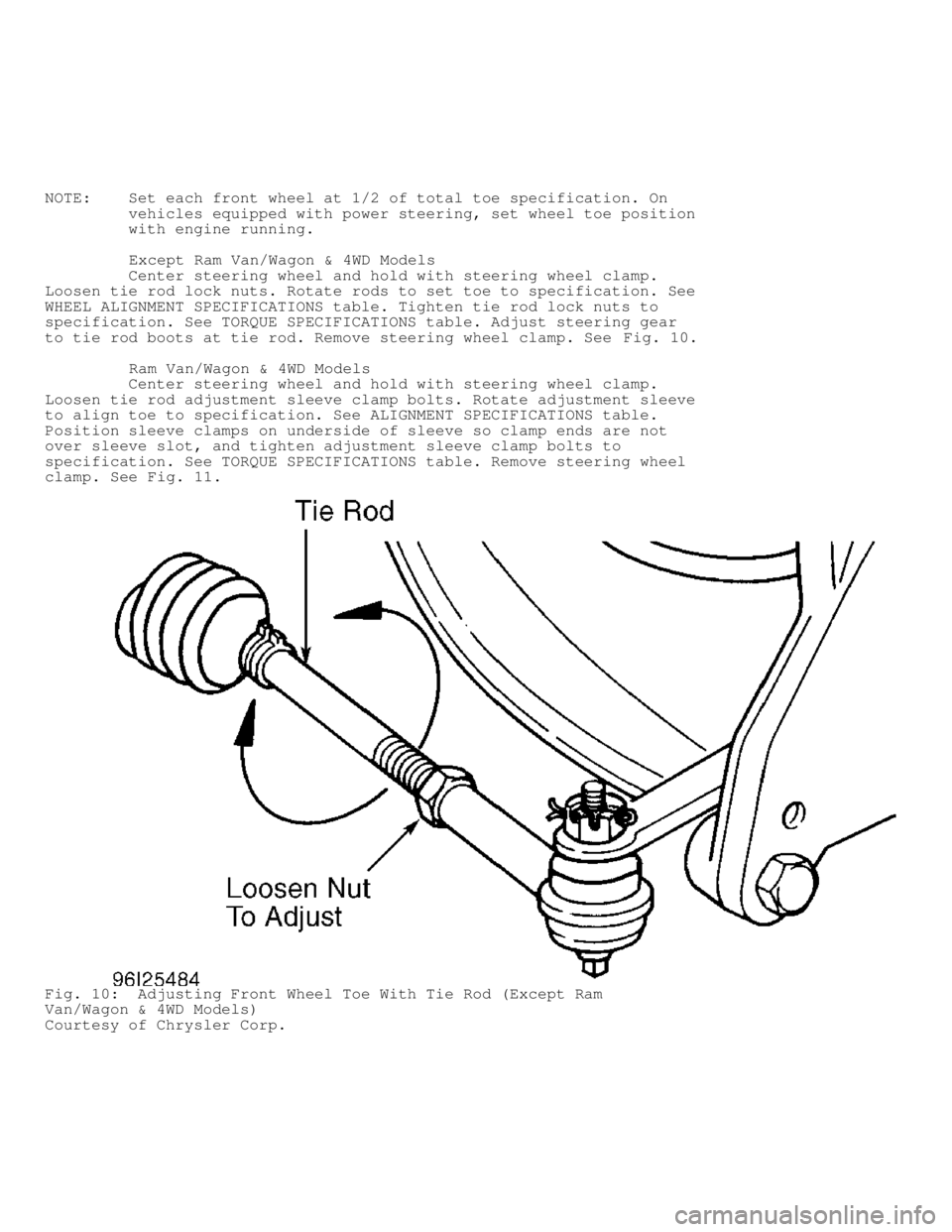Page 1556 of 1691
PFI VIN [3]. It is a perfect example of the peak and hold theory. The
waveform shows a 1-amp per division current flow, ramping to 4 amps
and then decreasing to 1-amp to hold the injector open.
Fig. 13: Injector Bank w/Normal Current Flow - Current Pattern
EXAMPLE #6 - CURRENT CONTROLLED DRIVER
This next known-good waveform is from a Ford 5.0L V8 CFI VIN
[F]. See Fig. 14. The pattern, which is set on a 250 milliamps scale,
indicates a 1.25 amp peak draw and a hold at 350 milliamps.
Fig. 14: Single Injector w/Normal Current Flow - Current Pattern
EXAMPLE #7 - CURRENT CONTROLLED DRIVER
The known-good current controlled type waveform in Fig. 15 is
from a GM 2.0L TBI VIN [1]. With the lab scope set at 2 amps per
division, notice that this system peaks at 4 amps and holds at 1 amp.
The next waveform is from the same type of engine, except
Page 1558 of 1691
Fig. 17: Single Injector w/Normal Current Flow - Current Pattern
VOLTAGE WAVEFORM SAMPLES
EXAMPLE #1 - VOLTAGE CONTROLLED DRIVER
These two known-good waveform patterns are from a Ford 4.6L
V8 VIN [W]. Fig. 18 illustrates the 64 volt inductive kick on this
engine, indicating no clamping is occurring. The second pattern,
Fig. 19 , was taken during hot idle, closed loop, and no load.
Page 1562 of 1691
Fig. 21: Injector Bank - Known Good - Voltage Pattern
EXAMPLE #4 - CURRENT CONTROLLED DRIVER
From 1984 to 1987, Chrysler used this type injector drive on
their TBI-equipped engines. See Fig. 22 for a known-good pattern.
Instead of the ground side controlling the injector, Chrysler
permanently grounds out the injector and switches the power feed side.
Most systems do not work this way.
These injectors peak at 6 amps of current flow and hold at 1
amp.
Page 1563 of 1691
Fig. 22: Single Injector - Known Good - Voltage Pattern
EXAMPLE #5 - CURRENT CONTROLLED DRIVER
These two known-good waveform patterns are from a Chrysler 3.
0L V6 VIN [3]. The first waveform, Fig. 23, is a dual trace pattern
that illustrates how Chrysler uses the rising edge of the engine speed
signal to trigger the injectors. The second waveform, Fig. 24, was
taken during hot idle, closed loop, and no load.
Page 1571 of 1691
Fig. 1: Measuring Riding Height (Dakota & Durango 4WD)
Courtesy of Chrysler Corp.
JACKING & HOISTING
FLOOR JACK
CAUTION: DO NOT place jack under any part of vehicle underbody. DO NOT
attempt to raise one entire side of vehicle by placing a jack
midway between front and rear wheels, as permanent body
damage could occur. DO NOT place jack under an axle tube,
aluminum differential, steering linkage, engine or
transmission oil pan, fuel tank or front suspension arm.
Caravan, Town & Country, & Voyager
To raise front end, place floor jack under front crossmember
forward flange, inboard of lower control arm pivot. To raise rear end,
place floor jack under rear axle, next to leaf spring mount. See
Fig. 2 .
Page 1576 of 1691

Application Front - In. (mm) Rear - In. (mm\
)
Gas Engine With
14" & 15" Wheels (1) ....... 29.04-29.82
(737.5-757.5) .......... 29.76-30.54\
(756.0-776.0)\
Gas Engine With 15",
16" & 17" Wheels ( 2) ....... 29.27-30.05
(743.5-765.5) ........... 30.0-30.78\
(762.0-782.0)\
CNG & Electric Vehicles ..... 30.46-31.24
(783.5-803.5) ........... 31.2-31.98\
(792.5-812.5)\
( 1) - With tire sizes P205/75R 15 and P215/65R 15.
( 2) - With tire sizes P215/70R 15, P215/65R 16 and 215/65R 17.
������������������\
������������������\
������������������\
������������������\
������������������\
������������������\
������������������\
�������������
HOIST
CAUTION: On Ram Van/Wagon, ensure there is adequate drive shaft
clearance while raising vehicle. DO NOT raise vehicle by
hoisting or jacking against front lower control arms. If rear
axle, fuel tank, spare tire and liftgate will be removed for
service, place additional weight on rear end of vehicle. This
will prevent tipping as center of gravity changes.
Caravan, Ram Van/Wagon, Town & Country, & Voyager
To raise vehicle on single and twin post type hoists, ensure
hoist pads contact vehicle frame behind front control arm pivots and
inside rear wheels on rear axle housing. Always use hoist adapters.
See Fig. 2 or 5.
Dakota & Ram Pickup
Vehicle may be raised on single or twin post swiveling arm,
or ramp-type drive hoists. If using swiveling arm hoist, ensure
lifting arms, pads or ramps are positioned evenly on frame rails, and
adequate clearance is maintained for transfer case (4WD models) or
skid plate. All hoists must be equipped with adapters to properly
support vehicle. See Fig. 3.
WHEEL ALIGNMENT PROCEDURES
FRONT WHEEL CAMBER & CASTER ADJUSTMENT
CAUTION: DO NOT adjust caster by heating or bending suspension
components. If caster angle is incorrect, replace
component(s) causing incorrect angle.
Caravan, Town & Country, & Voyager
1) Caster is factory preset and cannot be adjusted. Camber is
factory preset, but can be adjusted with a camber service kit. Raise
and support vehicle. While holding lower strut attaching bolts
stationary, loosen attaching nuts. See Fig. 6. Remove upper attaching
nut and bolt. Install camber service kit attaching/adjusting bolt and
nut. While holding bolt stationary, lightly tighten nut. Repeat
procedure for lower attaching nut and bolt.
2) Lower vehicle until vehicle weight is supported by
suspension. Bounce vehicle several times and allow suspension to
settle. Rotate new cam bolt to move top of wheel in or out to
specified camber. See WHEEL ALIGNMENT SPECIFICATIONS table. Tighten
through-bolt nuts to specification. See TORQUE SPECIFICATIONS table.
Page 1580 of 1691

NOTE: Set each front wheel at 1/2 of total toe specification. On
vehicles equipped with power steering, set wheel toe position
with engine running.
Except Ram Van/Wagon & 4WD Models
Center steering wheel and hold with steering wheel clamp.
Loosen tie rod lock nuts. Rotate rods to set toe to specification. See
WHEEL ALIGNMENT SPECIFICATIONS table. Tighten tie rod lock nuts to
specification. See TORQUE SPECIFICATIONS table. Adjust steering gear
to tie rod boots at tie rod. Remove steering wheel clamp. See Fig. 10.
Ram Van/Wagon & 4WD Models
Center steering wheel and hold with steering wheel clamp.
Loosen tie rod adjustment sleeve clamp bolts. Rotate adjustment sleeve
to align toe to specification. See ALIGNMENT SPECIFICATIONS table.
Position sleeve clamps on underside of sleeve so clamp ends are not
over sleeve slot, and tighten adjustment sleeve clamp bolts to
specification. See TORQUE SPECIFICATIONS table. Remove steering wheel
clamp. See Fig. 11.
Fig. 10: Adjusting Front Wheel Toe With Tie Rod (Except Ram
Van/Wagon & 4WD Models)
Courtesy of Chrysler Corp.
Page 1590 of 1691

�
WIN DO W S - P O W ER
�
1999 D odge P ic ku p R 1500
1999 ACCESSORIES & EQUIPMENT
CHRY - Power Windows
Caravan, Dakota, Durango, Ram Pickup, Ram Van, Ram Wagon,
Town & Country, & Voyager
DESCRIPTION & OPERATION
A permanent magnet motor moves each of the power windows,
including power vent windows. A positive and negative battery
connection to either of the 2 motor terminals will cause the motor to
rotate in one direction. Reversing current through these same 2
connections will cause the motor to rotate in the opposite direction.
Each individual motor is grounded through the master switch by a wire
attached to the instrument panel reinforcement.
Caravan, Durango, Town & Country and Voyager are equipped
with an Auto Down feature. Drivers window can be lowered without
having to hold the switch in the down position. Auto Down feature can
be activated by pressing down switch past first detent. Caravan, Town
& Country and Voyager have optional power vent windows. Power rear
vent windows are operated by switches mounted in driver's door panel.
NOTE: Power window circuits on Caravan, Town & Country, and Voyager
use Positive Temperature Coefficient (PTC) devices. The PTC
is a specified amperage solid-state resettable fuse. PTCs are
located in junction box behind driver's side of instrument
panel, to left of steering column. To reset PTC, all current
must be removed from PTC for approximately 20 seconds.
ADJUSTMENTS
WINDOWS
Remove door trim panel. See DOOR TRIM PANEL under REMOVAL &
INSTALLATION. Loosen bolts holding window to regulator. Raise window
fully, seating window in frame. Tighten bolts. Install door trim
panel.
TROUBLE SHOOTING
CARAVAN, TOWN & COUNTRY, & VOYAGER
Inspect both No. 8 and 9 (9-amp) PTCs in junction block.
Junction block is located under left side of instrument panel.
* Inspect fuse No. 23 (40-amp) in Power Distribution Center
(PDC). PDC is located on left side of engine compartment.
* Inspect ground at instrument panel left side cowl.
DAKOTA & DURANGO
Inspect circuit breaker No. 20 (20-amp on Dakota, 25-amp on
Durango) in fuse block. Fuse block is located on left end of
instrument panel.
* Inspect fuse No. 9 (40-amp) in Power Distribution Center
(PDC). PDC is located in left front corner of engine